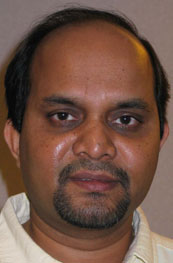 |
Kalipada Pahan, Ph.D. |
Dr. Pahan is one of eight Parkinson’s disease researcher groups who’ve received about $4 million in research grants through the new Community Fast Track research initiative, led by the Michael J. Fox Foundation for Parkinson’s Research (MJFF). The program officially named 18 projects which it will fund over two years through the investigator-initiated program, designed to stimulate novel, innovative and high-impact approaches to the field of Parkinson’s research.
Grant recipients were chosen from a large pool of international applicants assessed on the quality of novel science proposed, as well as the potential to increase understanding of Parkinson’s and eventually translate findings into patient treatments. Among this year’s awardees, three researchers will be receiving funding specifically to investigate Parkinson’s disease for the first time. These three grants represent an early success for the program, which aims to attract new scientists from other research fields to study Parkinson’s disease.
“Community Fast Track offers a channel through which Parkinson’s groups can contribute to an extremely selective peer-review award process,” said Deborah Brooks, executive director. “This collaboration is distinguished not only by the merit of each individual application funded, but also by the power of the Parkinson’s community as a whole to draw new researchers into the field and cultivate them for long-term development.”
Parkinson’s disease is a progressive, incurable neurological disorder that results from degeneration of neurons in a region of the brain that controls movement. The cause is unknown. Degeneration creates a shortage of the brain-signaling chemical known as dopamine, causing the movement impairments that characterize the disease.
“I’m thrilled to receive a grant to study Parkinson’s disease,” Dr. Pahan said. “Diseases of the brain affect everything. We want to know why these cells are dying and how they’re dying. It’s the most fascinating area to study.”
Dr. Pahan’s research team will study NF-kB’s potential role in the Parkinson’s disease process in laboratory mice models. Similar to multiple sclerosis, inflammation plays an important role in the loss of neurons in Parkinson’s disease. NF-kB, a protein present naturally in the body, is involved in the production of different inflammatory molecules. Their study will focus on the role of NBD peptides (peptides shown to inhibit the activation of NF-kB) in the disease process of Parkinson’s disease in animal models.
Dr. Pahan also is involved in studying multiple sclerosis, another neurodegenerative disorder, and has published results of the effectiveness of a variety of drugs on multiple sclerosis in laboratory mouse models.
Researchers have found when multiple sclerosis is present in animal models, the amount of NF-kB markedly increases in the brain and spinal cord. Dr. Pahan and his colleagues recently have found that NBD peptides markedly inhibit the inflammatory disease process of multiple sclerosis in mouse models. The results raise the possibility that NBD peptides may turn out to be an anti-neuroinflammatory drug.
Dr. Pahan said understanding how the disease works is important to developing effective drugs that protect the brain and stop the progression of Parkinson’s disease. “We know this drug works in suppressing the destructive process in the brain of MS in mouse models,” Dr. Pahan said. “We want to know if this drug does the same thing in mice that exhibit Parkinson’s disease.”
In the United States, at least 500,000 people are believed to suffer from Parkinson’s disease, and about 50,000 new cases are reported annually. The incidence is expected to increase as the average age of the population increases. The disorder appears to be slightly more common in men than women.